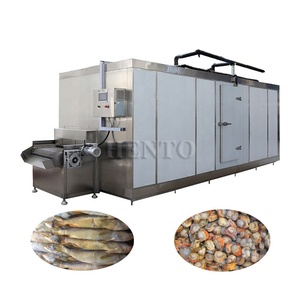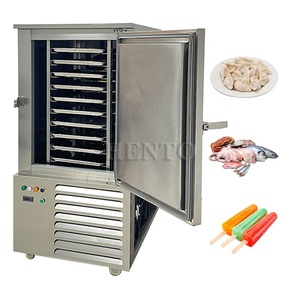
All categories
Featured selections
Trade Assurance
Buyer Central
Help Center
Get the app
Become a supplier

(2054 products available)




























In the realm of industrial machinery, quick freezing machine line plays a pivotal role in preserving and enhancing the quality of perishable goods. This equipment is integral to the refrigeration and heat exchange sector, offering solutions that ensure optimal temperature management for various products. quick freezing machine line is designed to rapidly lower the temperature of items, preventing spoilage and maintaining freshness over extended periods. Whether used in food processing, pharmaceuticals, or chemical industries, quick freezing machine line is essential for maintaining the integrity and safety of sensitive materials. With advancements in technology, quick freezing machine line has evolved to become more energy-efficient, environmentally friendly, and capable of handling larger volumes, thus meeting the growing demands of global markets.
The diversity of quick freezing machine line available today caters to a wide array of applications and industry needs. Common types include blast freezers, cryogenic freezers, and plate freezers. Blast freezers are known for their ability to quickly freeze large quantities of food products, making them ideal for food processing plants. Cryogenic freezers utilize liquid nitrogen or carbon dioxide to achieve ultra-low temperatures, suitable for pharmaceuticals and sensitive biological materials. Plate freezers, on the other hand, are designed for flat products like fish fillets, ensuring uniform freezing by direct contact. Each type of quick freezing machine line is engineered to offer specific advantages, such as speed, efficiency, and precision, ensuring optimal performance tailored to the specific requirements of different industries.
quick freezing machine line is equipped with various features that enhance its functionality and usability across different sectors. Key functions include rapid temperature reduction, moisture control, and energy efficiency, which are crucial for preserving product quality. Advanced models of quick freezing machine line incorporate features such as programmable settings, automated defrost cycles, and digital temperature monitoring, allowing for precise control and ease of operation. Energy-efficient compressors and insulation materials are employed to minimize energy consumption while maintaining consistent temperatures. The versatility of quick freezing machine line is further enhanced by its ability to integrate with existing systems, providing seamless operations in large-scale industrial environments. These features ensure that quick freezing machine line not only preserves the quality of products but also contributes to cost savings and operational efficiency.
The construction of quick freezing machine line involves the use of robust materials engineered to withstand extreme conditions. Stainless steel is commonly used for its durability and resistance to corrosion, ensuring a long lifespan and reliability of the equipment. Insulating materials such as polyurethane foam are essential for maintaining consistent internal temperatures and reducing energy loss. The choice of compressors, often ranging between 35-40 hp, is critical for efficient cooling performance, while the refrigeration systems typically operate within a range of 60 to 130 feet, depending on the size and capacity of the equipment. Additionally, environmentally friendly refrigerants are increasingly being used to minimize ecological impact and comply with global regulations. The combination of these materials and ingredients ensures that quick freezing machine line can deliver high performance and sustainability in demanding industrial settings.
Proper usage and maintenance of quick freezing machine line are essential for maximizing its lifespan and functionality. To use the equipment effectively, it is important to select the appropriate type based on the specific needs of the product and industry. Regular maintenance checks, including cleaning of coils and inspection of seals, are necessary to ensure efficient operation and prevent breakdowns. Calibration of temperature settings and monitoring of energy consumption can help optimize performance and reduce costs. In case of any malfunctions, it is advisable to consult with technical experts to address issues promptly. Additionally, training personnel on the correct handling and operation of quick freezing machine line can improve safety and efficiency in the workplace. By following these guidelines, businesses can ensure that their quick freezing machine line continues to deliver reliable and effective freezing solutions.
When selecting quick freezing machine line for industrial applications, it's crucial to consider several factors to ensure optimal performance and efficiency. The first step is to evaluate the specific requirements of your industry and the products you intend to freeze. For instance, food processing industries may prioritize blast freezers for their rapid cooling capabilities, while pharmaceutical sectors might opt for cryogenic freezers to maintain ultra-low temperatures for sensitive materials. Understanding the unique needs of your operation will guide you in choosing the most suitable quick freezing machine line.
Another critical consideration is the capacity and size of the quick freezing machine line. It's important to select equipment that can handle the volume of products you need to freeze without compromising efficiency. Larger operations may require high-capacity models that can accommodate bulk processing, whereas smaller enterprises might benefit from compact units that offer flexibility and space-saving advantages. Assessing the scale of your operations will help determine the appropriate size and capacity of the quick freezing machine line.
Energy efficiency is a key factor in choosing the right quick freezing machine line. With the growing emphasis on sustainability and cost reduction, selecting equipment with advanced energy-saving features can significantly impact your operational expenses. Look for models equipped with energy-efficient compressors, superior insulation, and programmable settings that allow for precise control over temperature and energy consumption. Investing in energy-efficient quick freezing machine line can lead to substantial savings over time.
When evaluating quick freezing machine line, key features to consider include temperature control, speed of freezing, and energy efficiency. Advanced models may offer programmable settings, automated defrost cycles, and digital monitoring systems, which enhance usability and precision. Additionally, selecting equipment with robust construction and durable materials ensures longevity and reliability in demanding industrial environments.
Ensuring the safety of products utilizing quick freezing machine line involves maintaining consistent temperatures and preventing contamination. Regular maintenance checks, such as cleaning and inspecting seals, are crucial for efficient operation. Additionally, training personnel on proper handling and storage practices can minimize risks associated with temperature fluctuations and contamination, thereby safeguarding product integrity.
Environmental considerations for quick freezing machine line include the use of eco-friendly refrigerants and energy-efficient technologies. Opting for equipment that uses refrigerants with low global warming potential and energy-saving features can reduce the environmental impact. Compliance with global regulations and standards further ensures that the freezing equipment aligns with sustainability goals.
The choice of refrigerant in quick freezing machine line significantly impacts its performance and environmental footprint. Refrigerants like R-290 and R-600a are gaining popularity due to their low environmental impact and high energy efficiency. Selecting equipment with suitable refrigerants can enhance cooling performance while adhering to environmental regulations and sustainability initiatives.
Regular maintenance of quick freezing machine line is essential to ensure optimal performance and longevity. Recommended practices include routine cleaning of coils, inspection of seals and gaskets, and calibration of temperature settings. Monitoring energy consumption can also help identify inefficiencies. Engaging technical experts for periodic inspections and addressing issues promptly can prevent major breakdowns and extend the equipment's lifespan.